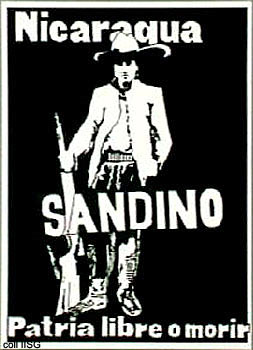Nicaragua 1979

FSLN poster
Shortly after the Marines left Nicaragua in 1933 (see chapter five of the book), the head of the National Guard, Anastasio Somoza, assumed political control. The U.S. , which had placed Somoza in charge of the Guard, was annoyed but unwilling to overthrow him, and so he remained in power until he was assassinated in 1956, at which point his two sons, first Luis and then Anastasio II, took over. All three members of the dynasty relied heavily on the National Guard, which in essence served as their private army; the Guard in turn, and the regime more generally, were strongly backed by the United States, which sent considerable economic and military assistance (for ten years, Nicaragua was the largest per capita recipient of military aid). The Somozas, strongly anticommunist, were happy to be of service to the U.S. and let their country's territory be used for proxy interventions in Guatemala and Cuba (see chapters five and six).
Things began to fall apart in the 1970s. Business leaders began to turn against Somoza because of his greed and the threat he posed to their markets; when a crusading newspaper editor was assassinated in early 1978, they organized a general strike. The rest of the country, disgusted at Somoza's rule and the Guard's brutality, joined in and Somoza, although putting down the protests, was constrained to announce that he would leave the presidency and the command of the Guard at the end of his term. Six months later, the Sandinista National Liberation Front (named after the same Sandino who fought the marines and was assassinated on the orders of Somoza's father), which had already begun to carry out more spectacular actions, launched attacks on National Guard troops in the country's larger cities. Although there was little doubt in Washington that the Guard would withstand the offensive, the problem was that in the absence of a political solution there would be increasing polarization, with opposition to Somoza drifting more and more in the direction of the Sandinistas. Since the latter were considered to be “extremists with links to Cuba ,” the U.S. would then be faced with a choice of nightmares; to avoid this, policy makers tried “to create some moderate third force choice between these two poles.” The instrument chosen was mediation between Somoza and the “moderate,” non-Sandinista opposition. This effort failed, ostensibly because of Somoza's obduracy but in fact because, with the end of the Sandinista offensive, U.S. officials saw little reason to incur the political costs involved in pressuring the Guard to separate itself from Somoza. (For example, the U.S. never tried to stop Israel, Guatemala, Argentina and other clients from selling weapons to Nicaragua; nor did the U.S. prevent IMF stabilization loans in 1979.)
At the end of May 1979, the Sandinistas began their “final offensive.” Within two weeks, the CIA had drastically changed its estimate of how long Somoza could hold on: from two years to a single week. Almost immediately, the issue in Washington became not whether or even when Somoza should leave Nicaragua , but how best to put together some force that would stop the Sandinistas from dominating the politics, and especially the military, of the post-Somoza era. Various proposals for military intervention were put forward: a multilateral peacekeeping force (rejected by most Latin American countries); a unilateral U.S. troop deployment (not accepted by Carter or the State Department); but soon it was clear that the only force which stood a chance was the National Guard itself. The problem was that because the Guard was so closely “associated in the minds of the people” with the Somoza family, the U.S. could not credibly supply it with assistance until some time after Somoza had departed. This meant that there had to be “a clean break,” i.e., an interim government whose members had been opponents of Somoza; but to get such persons to act independently of the Sandinistas while working with the National Guard was practically impossible. Hence, with great reluctance, the U.S. began to approach the Sandinistas to see if they might be willing to broaden their government-in-waiting; in addition, initial conversations were held with a dissident rebel commander. By this time, however, the Sandinistas were nearing the country's capital, and when Somoza finally departed, the Guard disintegrated within a day. 1
1) Vaky in Special Coordination Committee meeting, 4 September 1978 (paraphrase by Pastor 2002: 67; more generally, chs. 4-9); Vaky before Senate Foreign Relations Committee, 13 September 1978); Pezzullo in meeting with Somoza, 27 June 1979; both quotes from Morley (1994: 131, 194; more generally, chs. 5-7); State to Pezzullo, 28 June 1979 (ProQuest 2005); Lake (1989). It is worth noting that when Somoza offered to resign on 27 June, the response from the U.S. ambassador was to ask him to put it off while the U.S. got “organized a bit” (Pastor 2002: 124); this “organization,” as we saw, involved several weeks of fruitless negotiations while fighting raged. At one point, the ambassador even advised against a suspension of National Guard bombing on the grounds that this was “the only effective” means the Guard had for combating the Sandinistas (Pezzullo to State, 6 July 1979 [ProQuest 2005]).
